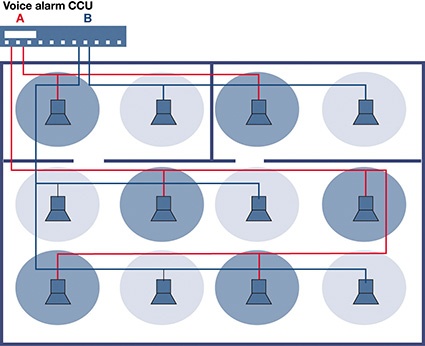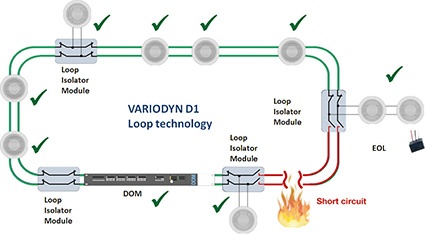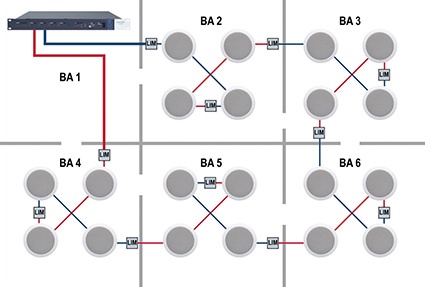Loop Technology for Voice Alarm Systems
Some manufacturers of professional voice alarm systems and electro-acoustic emergency warning systems are currently working on loop technology for the connection of 100 V loudspeak...



Some manufacturers of professional voice alarm systems and electro-acoustic emergency warning systems are currently working on loop technology for the connection of 100 V loudspeaker lines. The loudspeakers of a voice alarm system are still connected as a rule in spur technology, which brings with it a high risk of failure if the wire breaks or there is a short circuit. To minimize this risk, A/B cabling is used in systems built to DIN VDE 0833-4. In contrast to fire alarm systems, loop technology has not yet become established as standard in voice alarm systems because different requirements apply due to the higher power involved. A large step forward has now been taken by the new Variodyn D1 Loop Technology from Esser.
As a rule, loudspeakers are still connected to the voice alarm system via spur lines. However, if this line is broken, all the loudspeakers beyond the break fall silent. If there is a short circuit, the whole spur fails. To minimize this risk if a break or short circuit occurs, systems that are built to conform with DIN VDE 0833-4 (security levels 2 and 3) employ so-called A/B cabling whereby half of the loudspeakers in a room are driven by a different speaker line. This ensures that if a line fails (for example through a broken wire, a short circuit or earthing) half of the loudspeakers in that area remain in operation. If the alarm is sounded with only half the power, the sound level sinks by 3dB, provided the loudspeakers have been properly located. This drop in level is acceptable according to DIN VDE 0833-4.
Innovation in Voice Alarms
In contrast to fire alarm systems, loop technology has not yet become established as standard in voice alarm systems as a significantly higher power level has to be transmitted. This results in higher demands for these systems. It should be noted here that the Variodyn D1 Loop Technology is a ring wire technology and not a ring bus technology, as used in fire alarm systems. Further, complete protection against failure has not been required in the usual standards until now. If a system is built complying with DIN VDE 0833-4 or EN 60849, it is sufficient - depending on the specific application - to use either A/B or single cabling.
Loop technology does require separation modules that initially add to the cost. A second look, however, shows that the whole system can be significantly more economic as savings can be made in other places. So, depending on the circumstances, it may be possible to avoid using costly E30 cabling.
In Chapter 7.10.3 of DIN VDE0833-4 with regard to the construction of non-essential voice alarm systems it is stated that the otherwise necessary functional performance of a ring line system is not compulsory if it is ensured that the feed and return lines are in separate cables and that these cables are routed separately in buildings following fire protection principles. Further, it must be ensured with these ring line systems that the specified performance of the voice alarm system is not compromised by a single failure. That would be the case with the technology described here.
How Is Variodyn D1 Loop Technology Implemented?
It must always be ensured that the ring is monitored for broken wires or short circuits according to the standards. This is successfully achieved by the Variodyn D1 technology using the tried and trusted impedance monitoring method. A short circuit would represent that most critical case here. To provide the required protection against failure, so-called Loop Isolator Modules (LIM) are installed on the loop. These are supplied with power via the two-wire 100V loudspeaker ring and are constructed according to EN54-17 and approved by the VdS. They constantly measure the current in the ring. If a current above upper limits is detected the short-circuited segment is separated between two isolators. The rest of the ring line continues in full operation. If every loudspeaker is fitted with a short circuit isolator this means that, if a single wire fails, a failure protection of 100% has been achieved.
The Variodyn D1 loop technology provides an alternative to E30 cabling as here a ring line is fed with power from both sides and the Loop Isolator Modules approved to EN54-17 ensure that the functionality of the ring is maintained even when there is a short circuit. However, when choosing loop technology against E30 cabling it is advisable to discuss this with the appropriate authority before changing as there are different interpretations of the regulations on conduit installations (MLAR) both regionally and personally.
If you want to construct a system that doesn‘t have 100 percent protection against failure but where A/B cabling is required, it can be built as shown in the following diagram. Here a Loop Isolator Module (LIM) is always inserted between the A and B segments of a ring line. Then if there is a short circuit only the affected A or B segment will be cut out. This example provides the same level of failure protection as with A/B cabling in spur topology.
Summary
In the coming years, the continuous development of new technology in voice alarm systems will open up many opportunities to provide easy, powerful and safe operation. The new standards support the aspect of safety. Some manufacturers have meanwhile introduced systems that are freely programmable with modern software tools as standard. The use of digital transmission technology between the individual system components permits decentralized growth of the system. This allows the optimization of larger systems with regard to the routing of cables, which can lead to significant cost savings. Because of the many advantages, it is safe to assume that 100V loop technology will emerge as a standard in the medium to long term.
The advantages include:
- 100% failure protection (with an isolation module in every loudspeaker)
- replacement of the A/B cabling with simple means
- E30 cabling partially unnecessary
- no need for a second loudspeaker in small rooms
most read

GIT SECURITY AWARD 2026 - The winners have been announced!
GIT SECURITY AWARD 2026: The best safety and security solutions of the year - now an overview of all winners

Video security & video management: the winners of category C at the GIT SECURITY AWARD 2026
GIT SECURITY AWARD 2026: Video Security & Video Management - an overview of the most innovative solutions

Integrated and Futureproof: Traka’s Next Chapter
Interview with Stefni Oliver on Traka’s Vision for the Future

Security management, building security & perimeter protection: the winners of category E at the GIT SECURITY AWARD 2026
GIT SECURITY AWARD 2026: Security management, building security & perimeter protection - an overview of the most innovative solutions









